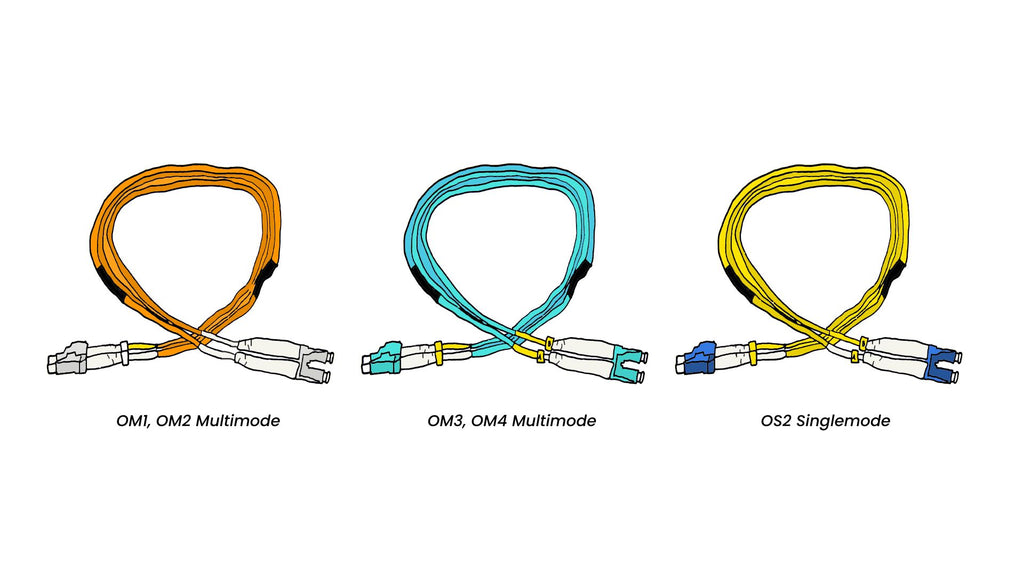Payment methods accepted

Why Is VIOLET In My Fiber Cabling Installation?
Written by Ben Hamlitsch, trueCABLE Technical and Product Innovation Manager RCDD, FOI
Over the centuries we have seen color used in various ways as a means of identification. Color remains the easiest way to identify, recognize, and classify just about anything, and it has always been an integral part of the fiber optic industry—from the colors of individual fibers to the outer jacket of a cable.
Fiber optic cable jacket colors have always been, up to this point, 3 distinct colors; Orange, Aqua, and Yellow. Orange cable jacket identifies OM1 and OM2 multimode fiber, Aqua cable jacket identifies OM3 and OM4 multimode fiber, and Yellow, you probably guessed it, identifies singlemode fiber cable.

So, if these are the 3 standard colors, why are we talking about a fourth: Violet?

You may be thinking, “Is this a new type of fiber optic cable? I didn’t get that memo.” Despite what you may have heard or seen, there isn’t a new type of optical fiber cable. But there is a new color—Violet—and it has a lot to offer when it comes to identifying OM4 fiber in the fiber enterprise and data center.
Do you remember the orange 62.5 micron multimode fiber, otherwise known as OM1? When 50 micron OM2 multimode fiber came on the scene, it too was orange.
When technicians see the same color cable in the same data center, it’s often assumed that they are of the same type. To truly differentiate, their only choice is to follow the cable back and carefully examine the tiny (sometimes illegible) cable legend or check their documentation. That’s precisely why the industry experienced countless issues when technicians inadvertently spliced orange OM1 to orange OM2. This caused a lot if issues, including attenuation loss, because OM1 fiber has a 62.5 micron core and OM2 has a 50 micron core.
Then OM3 came out and they changed the color to aqua. At least now there would be no confusion between aqua and orange. Then came OM4, one would think that we would have learned a thing or two since then. But when TIA/EIA approved the latest OM4 fiber in 2009, it remained the same color as its OM3 predecessor—Aqua.
So here we are with history repeating itself and technicians not having a way to easily differentiate between OM3 and OM4 fiber, especially when staring at the front of a panel where all the adapters look the same.
To solve the problem, the European market introduced a new violet color for OM4, Erika Violet, throughout much of mainland Europe. This new color has been accepted in Europe for nearly two years and adoption is on the rise elsewhere.
Following the precedence set in Europe, several North American companies are now offering violet components as their new standard for OM4 fiber. At trueCABLE we believe when it comes to identifying fiber systems quickly and ensuring there are no mix ups combining OM3 with OM4 fiber, this calls for a different fiber color to quickly identify and ensure performance. Violet OM4 fiber cable can be a big-time saver for the cabling network technician.
With Violet fiber cable, adapters and connector bodies now prominently display in pathways and at fiber panels. It’s easy to know for sure that it’s OM4. And even if fiber jumpers are color-coded per application, the connector body remains Violet. Mistakenly plugging in the wrong fiber jumper type is virtually impossible.
While OM3 and OM4 might look the same and have the same core size, OM4 fiber offers better performance than OM3. And just like we saw with orange OM1 and OM2 fiber, when OM3 and OM4 are inadvertently spliced or connected at panels, it can cause performance issues that are difficult to troubleshoot.
With today’s optical loss budgets being more of a concern than ever as we prepare for 40 and 100 Gig, using an OM3 connector when you should’ve used OM4 can push your loss over the limit. Furthermore, mixing the two can cause a loss of bandwidth and result in an increased bit error rate (BER) on links.
Next time you are planning your OM4 multimode fiber installation, take a look at the OM4 multimode Violet products from trueCABLE.
STAY CONNECTED!
trueCABLE presents the information on our website, including the “Cable Academy” blog and live chat support, as a service to our customers and other visitors to our website subject to our website terms and conditions. While the information on this website is about data networking and electrical issues, it is not professional advice and any reliance on such material is at your own risk.

































